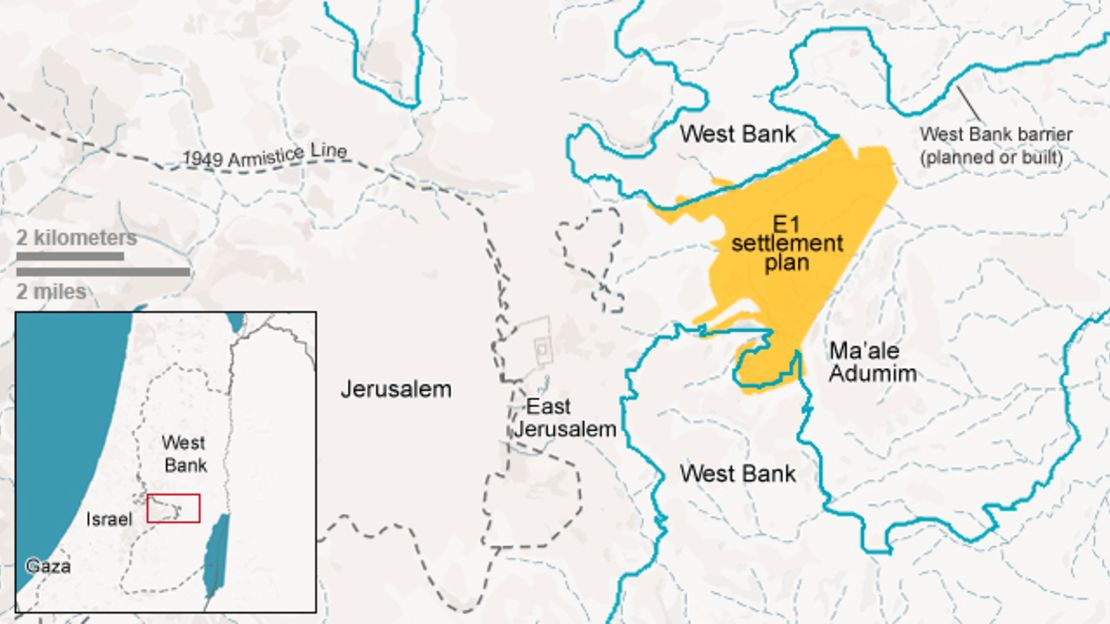Story highlights
Israel plans to begin construction of settlements in the East 1, or E1, zone in the West Bank
Comes after the U.N. voted to grant Palestine non-member observer status
Palestinians believe construction here would essentially cut the West Bank in half
Group: Currently 137 Israeli settlements in the West Bank, with about 325,000 inhabitants
International Correspondent Fred Pleitgen reports from the site of E1, a controversial settlement that the Israeli government plans to build.
What is E1?
I was standing on the barren hilltops East of Jerusalem and it is hard to believe the area could be at the center of an international controversy. E1 stands for East 1 and marks territory that the Israeli government has slated for settlement construction in the West Bank. It’s about 12 square kilometers (4.6 square miles), and when completed will touch the outskirts of Jerusalem.

The construction in the E1 area would be an expansion of one of the largest Israeli settlements in the West Bank, Ma’ale Adumim, with about 40,000 inhabitants, and would merge it with the greater Jerusalem area.
Why has the plan caused so intense international reaction?
After the United Nations General Assembly vote on November 29 to grant the Palestinians the status of a non-member observer state in the body, Israel announced settlement construction in the West Bank and East Jerusalem as a response, saying part of that would likely take place in the E1 area.
The Palestinians believe construction here would essentially cut the West Bank in half and could also impede access from the West Bank to East Jerusalem, which the Palestinians would like to see as the capital of any future Palestinian State. In an interview with CNN, the Palestinians’ chief negotiator Saeb Erekat condemned the plan saying: “There is no chance for a Palestinian state. I mean it is impossible. Anyone who looks at the map, looks at the geography will know exactly that this decision means that there is no more two-state solution.”
How many Israeli settlements are there?
According to the settlement monitoring group Peace Now, there are currently 137 Israeli settlements in the West Bank, with about 325,000 inhabitants in total. The settlements are essentially Israeli towns of various sizes in Palestinian territory. Many of them, like Ma’ale Adumim, look almost like any other Israeli town with everything from supermarkets to shopping malls and schools.
What is their legal status?
The legal status of the settlements is in dispute. The United Nations and many scholars of international law consider them illegal, but Israel and some experts like the late Eugene Rostow of the Yale Law School and Julius Stone, international law professor at the University of Sydney, have said they are legal. The Palestinians want Israel to give up most settlements as part of any future two-state solution, but many believe that is not realistic considering the size of some of them.
How do settlements impact the peace process?
Settlements are one key reason why there have been no negotiations between the Israelis and Palestinians for several years. The Palestinians say they will only return to the table if Israel freezes all settlement construction, while Benjamin Netanyahu’s government wants negotiations without preconditions. The dispute over new construction in the E1 sector is adding fuel to the fire and the U.N. believes it might destroy any chance of a two-state solution for good.
How would ordinary Palestinians be affected by E1 development?
For average Palestinians in the area, the concerns are immediate. Attala Titi, a taxi driver in the town Eizzaria near Jerusalem, told me he fears additional detours and checkpoints if settlements are constructed in the E1 area. “If they build this settlement and close off our roads it will mean that my trip from Hebron to Jericho would take between five hours to a whole day.”
How about people currently living in the settlement?
Ma’ale Adumim’s Mayor Benny Kashriel is happy at the prospect of expanding the settlement, a project that has been on hold for years.
“This place, this residential neighborhood, it is in the Ma’ale Adumim municipality, part of Ma’ale Adumim municipality, government land. It has to be built for our young couples,” he told me from his office.




